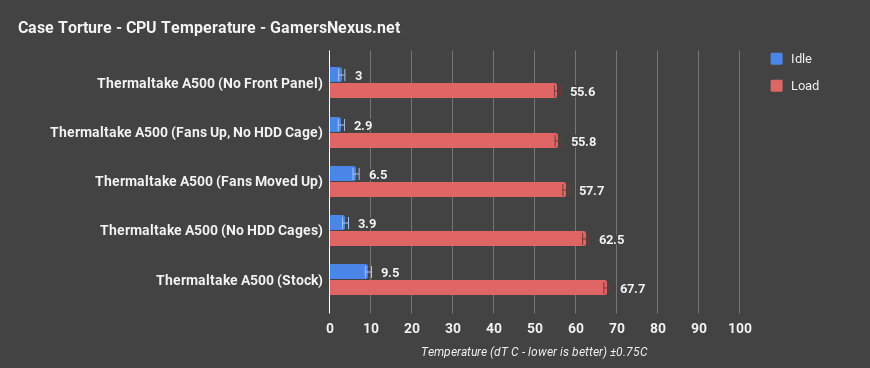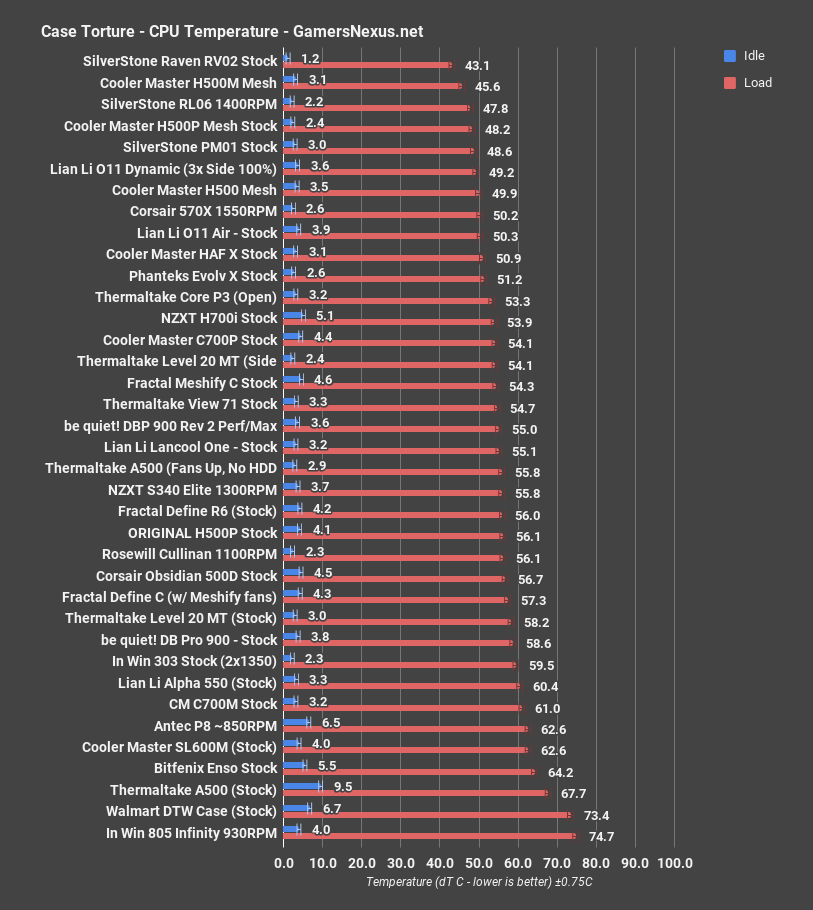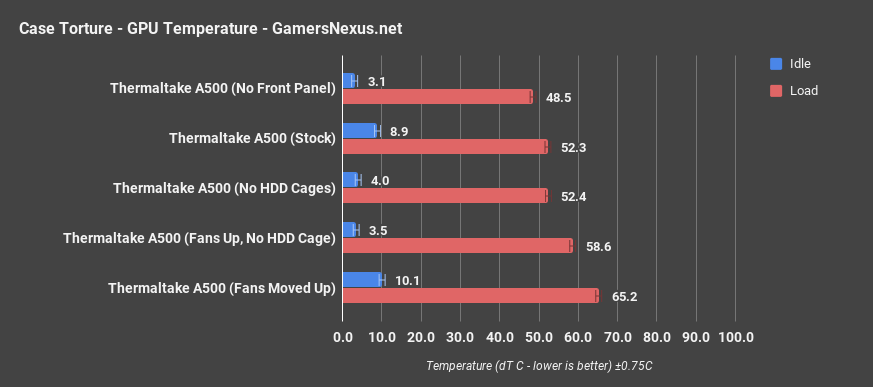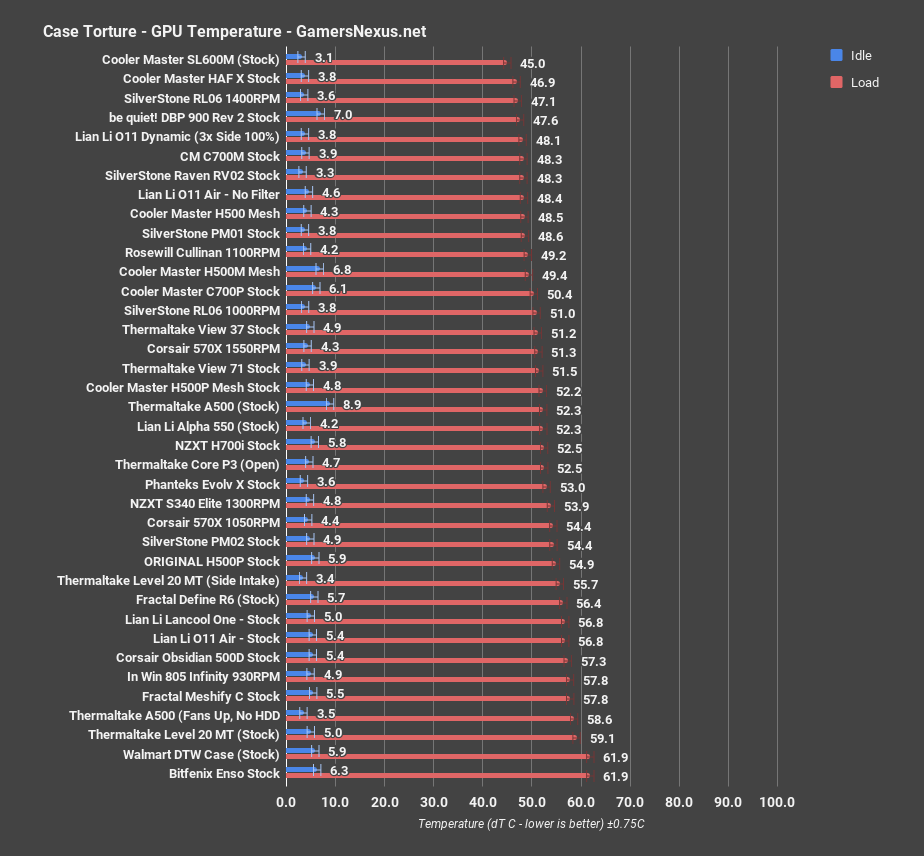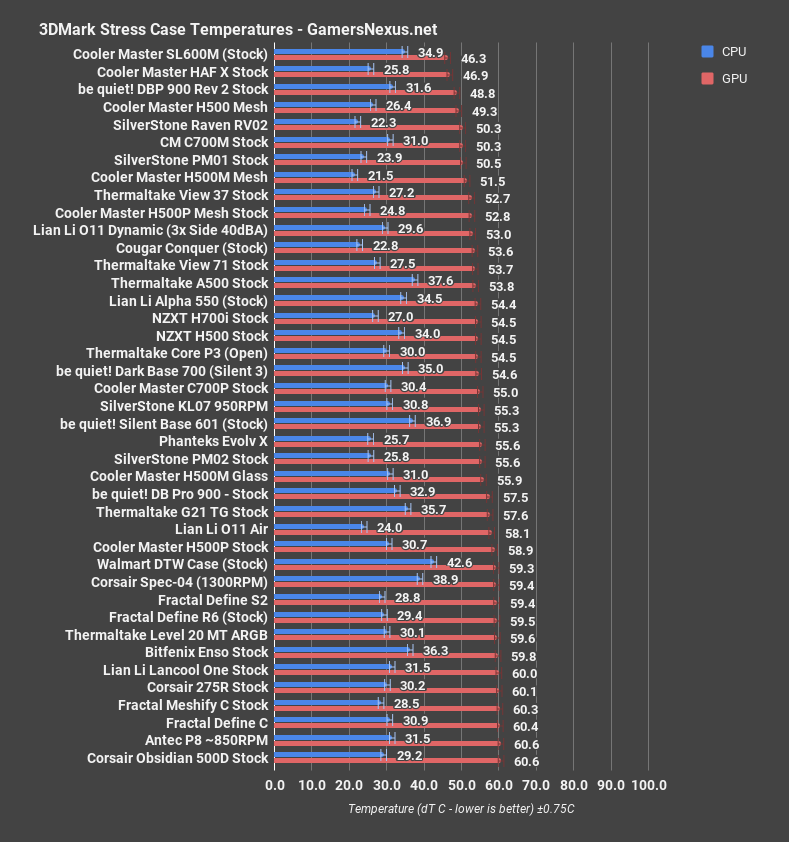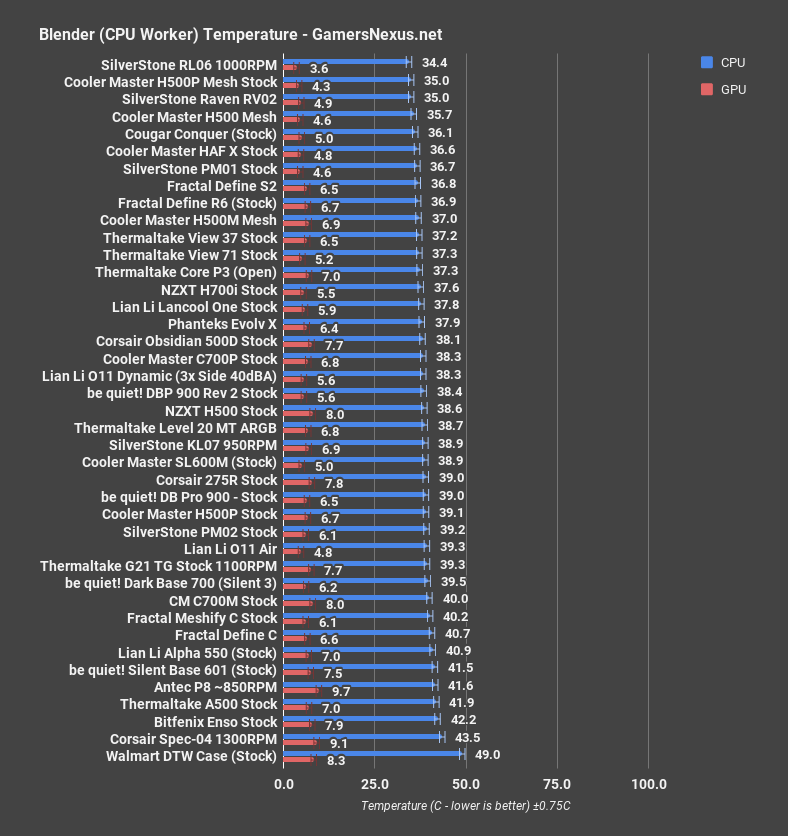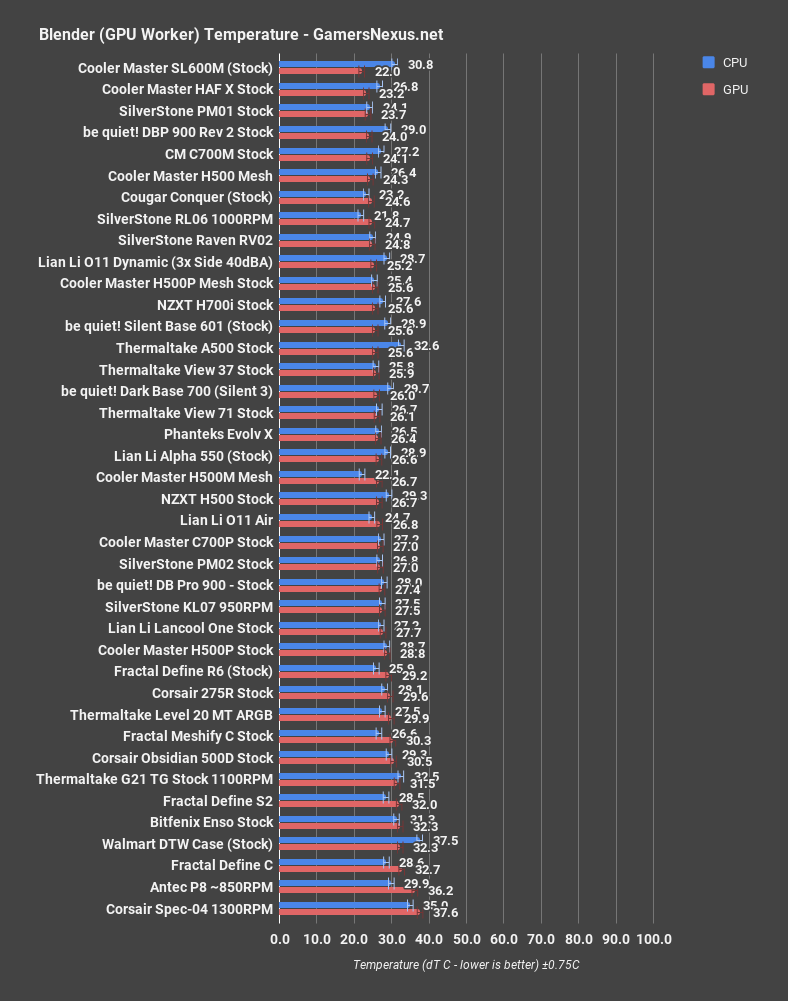We recently reviewed (and weren’t impressed by) the Thermaltake Level 20 MT, but Thermaltake is nothing if not prolific, and there’s always a new enclosure to try. The A500 TG was released back in October under the full name “Thermaltake A500 Aluminum Tempered Glass Edition Mid-Tower Chassis,” and enters the lab today for a full thermal, acoustic, and build quality review.
Thermaltake’s A500 case primarily touts aluminum, glass, and trend-advancing features without necessarily introducing new ideas. It’s OK for a case to advance features rather than invent them, but it really must make advancements at the $250 price-point of the A500.
Build Notes
The side panels are hinged and are secured at the front with both magnets and large rotating latches. The latches can be fairly stiff and difficult to operate without a screwdriver, but they’re also only really necessary for transport, since the magnets are plenty strong enough to hold the doors shut otherwise. They’re also knurled so that it is possible to unscrew them by hand, unlike similar latches made by Cooler Master. The doors lift off their hinges and the hingepins are of uneven length, very helpful for guiding them back into place as we’ve mentioned in past reviews. The hinges are thick and strongly attached to the glass panels, which are impressively well-aligned with the edges of the case. Since the panels aren’t screwed directly onto the chassis, they must be aligned entirely by the placement of the hinges, so tolerances are tight.
Thermaltake A500 Case Specs
Model | A500 Aluminum TG |
Case Type | Mid Tower |
Dimension (H x W x D) | 560 x 236 x 510 mm (22 x 9.3 x 20.1 inch) |
Net Weight | 14.82 kg / 32.67 lb |
Side Panel | 4mm Tempered Glass x 2 (Left & Right) |
Color | Exterior: Space Gray; Interior : Black |
Material | Aluminum & SPCC |
Cooling System | Front (intake) : 120 x 120 x 25 mm fan (1000rpm, 22dBA) x 2 Rear (exhaust) : 120 x 120 x 25 mm fan (1000rpm, 22dBA) x 1 |
Drive Bays | 2.5” or 3.5” x 4 (HDD Cage) 2.5” or 3.5” x 2 (HDD Cage); 2.5” x 1(HDD Bracket) |
Expansion Slots | 8 + 2 |
Motherboards | 6.7” x 6.7” (Mini ITX), 9.6” x 9.6” (Micro ATX), 12” x 9.6” (ATX) |
I/O Port | USB 3.0 x 2, USB 2.0 x 2, HD Audio x 1, Type-C x 1 |
PSU | Standard PS2 PSU (optional) |
Clearance | CPU cooler height limitation: 160mm VGA length limitation: 295mm(with HDD rack) 420mm(without HDD rack) ※Suggested VGA thickness up to 40mm(2-slot reference card standard) with 7mm space for ventilation if extending for VGA card. PSU length limitation: 220mm |
Fan Support | Front: 3 x 120mm , 3 x 140mm Top: 3 x 120mm , 2 x 140mm Rear: 1 x 120mm |
Radiator Support | Front: 1 x 360mm , 1 x 420mm Top: 1 x 360mm , 1 x 280mm Rear: 1 x 120mm |
MSRP | $250 |
The A500 is a heavy case that feels sturdy. The top, front, and to some extend the bottom of the case are covered with plates of 3mm thick aluminum, and the sides with 4mm thick tempered glass. Both the front and top panels snap into place with plastic ball-and-cup fasteners, which is one of the more thoughtful and easy to use designs we’ve seen, although the pieces are interdependent: the side panels should be opened to more easily remove the front panel, and the front panel should be removed to get off the top panel. Underneath the top panel are several mounting points for fans, but no removable fan tray, which is a feature we’d like to see in higher-end cases like this. The nature of the glued-in filters means that they can’t be removed without permanently altering the case, so typical top exhaust configurations will be slightly hampered by the unnecessary obstruction and dust buildup.
Top radiator mounting is extremely straightforward: the mounting rails are 360mm long and 5cm above the top edge of the motherboard, so there should be plenty of space for any normal AIO. The front mount is nearly the same, but radiators mounted inside the chassis must share space with the HDD cages, so placing a 360mm radiator in the front of the case removes all 3.5” drive support.
The stock arrangement of fans, hard drive cages, and filters at the front of the case is suboptimal. The least serious issue is the hard drive cages, which can be removed completely or repositioned along a rail at the front, similar to some Cooler Master cases. The stock configuration with two cages installed behind the intake fans is bad for thermal performance, but it makes more sense to ship the cages preinstalled rather than loose, and they’re so easy to move around that this doesn’t count as a strike. This led to some extra testing in the thermal section as we tried to find the optimal case configuration by removing cages and shifting fans around. Many of the cases we review don’t support more than two 3.5” drives, and having some extra HDD cages on hand is more positive than negative.
The two stock intake fans are both positioned as low as possible on the front of the case, so that both of them are pointed more towards the PSU shroud and GPU rather than the CPU. This, especially if combined with the hard drive cages, makes it unlikely that cool air will find its way to the top of the case. The three 120mm case fans all spin at ~1000RPM max, which isn’t enough to effectively pull air in through the mesh strips along either side of the front panel, although there is also an unfiltered hole at the bottom. There is no removable filter in front of the fans. The only normal slide-out filter is the one on the bottom of the case, which is effective but slides backwards and forwards freely without snapping into place.
Both side panels are transparent, so cable management needs to be good, which it is. There are velcro straps screwed into the chassis in a line that can handle the bulk of power and I/O cables. There’s 3cm of space between the glass side panel and the chassis across its entire width, so there’s no need for a special cable management channel. Compare that to the more typical 1.5cm gap in the Level 20 MT and it’s clear just how much space that is. It’s also reasonable to remove the HDD cage underneath the shroud for extra cable space, since there are four 3.5” sleds that can be mounted above the shroud.
Yes there is a vertical GPU mount, and no we did not test it. We don’t recommend mounting air-cooled cards up against unventilated side panels, and we’ve already proven that it’s a bad idea multiple times. It should be fine for liquid cooled cards, and Thermaltake has put a little more effort into their implementation than most by including a removable mounting plate for a PCIe riser cable.
Case Testing Methodology
GN Case Testing Bench (Sponsored by CableMod)
| Component | Courtesy Of | |
| Video Card | MSI GTX 1080 Gaming X (OC Mode) | MSI |
| CPU | Intel i7-6700K @ 4.4GHz | GamersNexus |
| CPU Cooler | MSI Core Frozr L | MSI |
| Motherboard | MSI Z170A Gaming M7 | MSI |
| Memory | Corsair Vengeance LED 32GB 3200MHz | Corsair |
| SSD | Samsung 850 EVO 120GB | Samsung |
| PSU | Corsair RM650x | Corsair |
| Cables | CableMod Pro Mesh Cables | CableMod |
| Case | This is what we're testing! | - |
The video card is configured to run at 55% fan speed at all times.
Prior to load testing, we collect idle temperature results for ten minutes to determine the unloaded cooling performance of a case's fans and air channels. Thermal benchmarking is conducted for 1400 seconds (23 minutes), a period we've determined sufficient for achieving equilibrium. The over-time data is aggregated and will occasionally be compiled into charts, if interesting or relevant. The equilibrium performance is averaged to create the below charts.
Load testing is conducted using Prime95 LFFTs and Kombustor “FurMark” stress testing simultaneously. Testing is completely automated using in-house scripting, and executes with perfect accuracy on every run.
We recently validated our test methodology using a thermal chamber, finding our approach to be nearly perfectly accurate. Learn more here.
Thermals & Noise
Thermal testing for the A500 was exhaustive, including a total of 5 configurations just for the A500 alone. Our testing configurations focused first on the stock A500 enclosure, then aimed to improve performance to reach full potential by modifying the stock setup. Test variations offer a look at performance without any hard drive cages obstructing intake, a test with the front fans shifted up for more balanced airflow, a test with the fans moved up and the hard drive cages removed, and then a standardized test without the front panel.
Let’s get a CPU torture chart on the screen to look at thermal performance of the Thermaltake A500 case only against itself. We’ll add comparative data in the next chart.
CPU Torture
Stock, the case didn’t do well: It’s at about 68 degrees Celsisu over ambient for CPU torture thermals. We postulated that most of this poor performance was to blame on the fan positioning, so shifted the front fans upward for balance. This brought thermals down to 57.7 degrees Celsius over ambient, with idle temperature also dropped to 7 degrees from an impressively high 9.5 over ambient. Removing the hard drive cages but keeping the stock fan configuration put us at 63 degrees over ambient, enabling a noteworthy performance improvement just by removing unused hard drive cages. We like that Thermaltake includes them with the case, so we’ll just note that you should pull them out if they have no immediate use. Moving the fans up and removing the hard drive cages doesn’t do as much for as, since it also moves most the airflow path above the cages – we end up at 56 degrees over ambient with this setup. Removing the front panel entirely and leaving the fan configuration and drives stock, we end up measuring a CPU temperature of 55.6 degrees over ambient – about the same as the previous measurement, and within margin of error.
Comparatively, with just the stock and best-case configuration on the chart, that puts the A500 near the Lancool One when in its stock configuration, both within margin of error of each other.
The NZXT S340 Elite is similar in performance to the modified A500. Thermaltake’s View 71 in stock configuration outperforms the modified A500 by roughly 1-degree Celsius, which is a massive improvement over the stock A500 performance of 68 degrees. The Dark Base Pro 900 is priced about the same and ends up near the A500, for comparison by price-point. The Cooler Master H500M also deserves highlight and thermally decimates the A500 while costing the same. The A500 in stock configuration is between the Enso and the Walmart DTW, which is impressively poor performance. This speaks to limitations of the fan positioning, the front panel, and the drive cage obstructions. Fortunately, two of these things are easily resolved, as illustrated with the modified result. If you’re willing to remove the drive cages and move the fans up, the A500 does fine. It’s not impressive, but it’s fine – it’s about average. No better, no worse. Just don’t keep it in the full stock configuration. If you’re adding closed-loop or open loop coolers, these can obviously overcome many of the limitations – but it’ll primarily be by brute force.
GPU Torture
Moving on to GPU torture and starting first with just the A500, the stock configuration does better this time around. Stock performance measures 52 degrees over ambient for the GPU diode, significantly better than CPU performance as a result of the fan positioning pointed straight at the GPU. Removing the front panel is the only means we improved performance over stock, planting the A500 at 49 degrees over ambient. That shows that the front panel isn’t a massive inhibitor to GPU thermals, and that’s because, again, both front fans are blasting the GPU with air. Removing the hard drive cages doesn’t impact performance. We’re within error margins, so the results are functionally the same. Removing the cages and moving the fans up posts a temperature increase of about 6 degrees over stock. This is a better balance than the stock configuration, we think. CPU temperature drops significantly with this layout, but GPU impact isn’t nearly as large. If you want to run relatively stock, we’d recommend this layout. Just moving the fans increases GPU temperature the most, as expected, because we now have obstructions and less direct airflow to the GPU.
Comparatively, the A500 stock configuration is about tied with the H500P Mesh, a case which does reasonably well in GPU thermals and very well in CPU thermals; in fact, if you’re going for thermals and a similarly sized case, we’d just recommend the H500P Mesh over the A500. It’s about $100-$150 cheaper, depending on when you buy it, and has more balanced thermal performance for both CPU and GPU components. The View 71 is about 1-degree ahead of the A500, just for another TT reference point. It’s really not bad, just imbalanced to favor GPU thermals, and even those are average. At $250 for the A500, we should also highlight the Cooler Master H500M Mesh at 49 degrees, which costs about the same and is also significantly more balanced.
3DMark
3DMark testing is next. The Thermaltake A500 ends up around where the View 71 sits, roughly at 54 degrees over ambient for the GPU. That said, if you take a look at CPU thermals, you’ll notice that the A500 runs about 10 degrees hotter. The Cooler Master H500M Mesh runs at about 52 degrees over ambient for the GPU – not a huge change, but the CPU runs at 22 degrees, which is a huge change. Overall, gaming workload performance is represented by 3DMark, and results are overall average for the A500.
Blender
Blender render testing on just the CPU reduces the overall heat generation inside of the case, instead only running the CPU at maximum load. This is a realistic and common use case, but one which stresses the A500 more than most as a result of its already-detailed CPU cooling problem. The A500 operates at around 42 degrees over ambient for the CPU. It’s fine, it’s not going to cause any damage, but it’s still nearly the worst on the chart. The only cases worse than this are the Bitfenix Enso, which has zero holes in the front panel, the $50 Spec-04 that Newegg recently struggled to give away, and the Walmart DTW case, which, well, you know how that went.
For GPU thermals with Blender, the A500 ends up a bit above average. The GPU does well with a 25.6-degree result, tying with the H500P Mesh, H700, and Silent Base 601, but the CPU result is hotter than most. Considering the CPU isn’t doing anything other than scheduling the GPU, its performance is unimpressive.
Noise
Noise levels allow the A500 to be partially vindicated after its embarrassing performance in the thermal section. The A500 ends up at about 35.1dBA, right around the Bitfenix Shogun, the Dark Base Pro 900, and better than the Cooler Master H500M’s 40.7dBA result. Still, as we recently showed in our airflow vs. silence testing, having better airflow means that you can reduce fan noise to reach equivalent noise levels. Either way, the A500 at least does decently in noise, but this does teach us that its biggest inhibitors are first its fans, then its fan positioning and obstructions. The static pressure is just not that good.
Conclusion
$250 is a lot of money to spend on a computer case, but a Google search at the time of this writing (about two months after the case launched) turns up a Fry’s Electronics listing for $200 with an additional $20 rebate. The MSRP would be easier to handle with some of Thermaltake’s higher-end fans included, but $200 is a reasonable price, it’s just still in fierce competition with other $200-$250 heavyweights. We can’t outright recommend the A500 at $250. It isn’t offensive, it’s just outclassed at its price-point. At $200, it is easier to look the other way if someone wants to buy it, but not easy enough to flat-out recommend.
This is a big case that uses expensive materials and looks fancy, but it requires some reconfiguration and the purchase of some better fans to be truly good. Competitors nearby include the be quiet! Dark Base Pro 900 Rev 2, the Cooler Master H500M, the Phanteks Evolv X (without upgrade kit), and the NZXT H700i.
Editorial, Testing: Patrick Lathan
Thermal Editorial: Steve Burke
Video: Keegan Gallick, Josh Svoboda, Andrew Coleman
